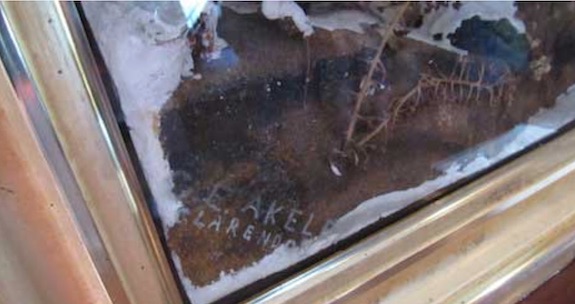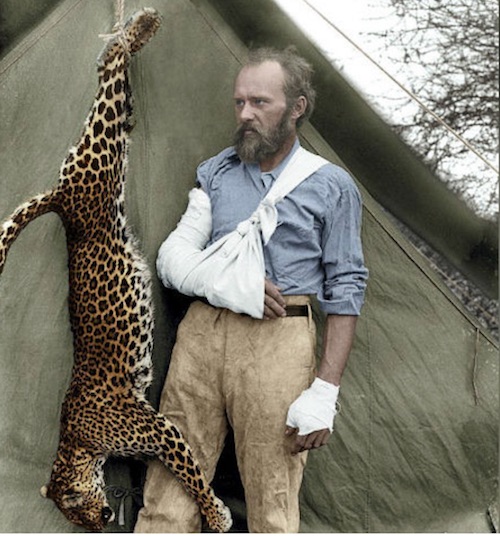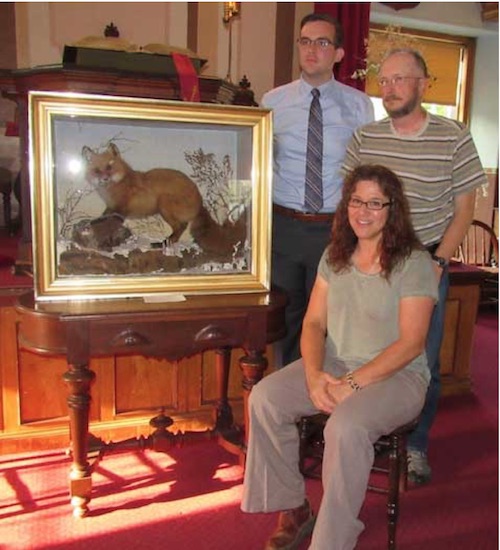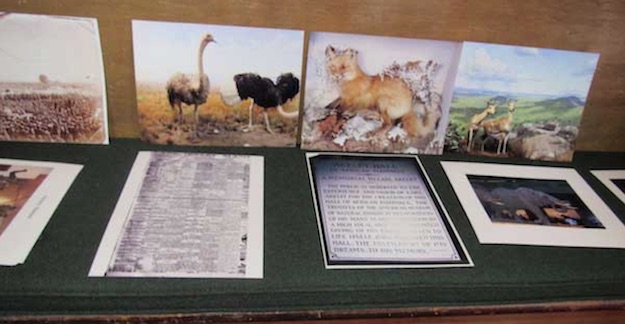Historic Childs: The Akeley Fox, early work of famed taxidermist from Clarendon
By Doug Farley, Cobblestone Museum Director – Vol. 2. No. 45
GAINES – The Hamlet of Childs is the current home for an outstanding artifact of the mid-19th century. The name settled upon for this object is “The Akeley Fox,” in homage to the taxidermy artist, Carl Akeley, who created the diorama in 1879.
Pictured at top in 1979 is Mr. John Seager, along with the fox his great grandfather Francis Harling shot over 140 years ago. In 1979, Mr. Seager gave his family heirloom to the Cobblestone Museum for its permanent collection in memory of his parents Agnes Harling Seager and John Seager.
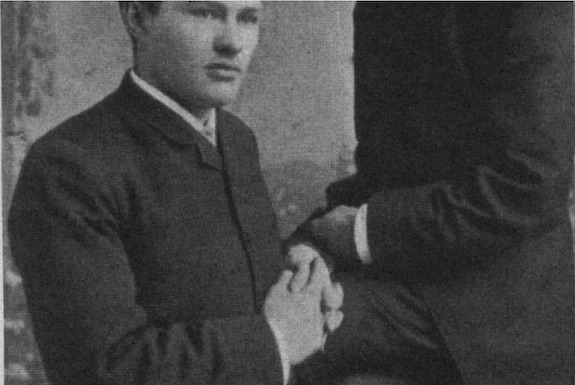
Young Carl Akeley – Photo courtesy the Field Museum
The story goes that sometime in 1879m Francis Harling lay near a fox run in a Barre Swamp almost a full day before this specimen came along. At the time, a young Carl Akeley of Clarendon (shown above) was in his late teens or early twenties and was learning the techniques of taxidermy under the tutelage of David Bruce from Brockport. Knowing Akeley, Francis Harling purposely procured the fox for him to mount. The fox is depicted in a large gold-framed shadow box just as she had killed a partridge.
The Akeley Fox is one of his early works. It is signed on the reverse side of the glass, “C .E. Akeley, Clarendon”
In the late 19th Century Akeley went on to become the great world renowned African explorer and established the African Hall in the American Museum of Natural History in New York City. He was noted as being one of the first taxidermists to place specimens in their natural surroundings and traveled with Theodore Roosevelt and George Eastman on several safaris. One of his staunchest supporters was none other than J. Pierpont Morgan. The image above depicts Akeley surviving a leopard attack on one of his many safaris in Africa. He captured the leopard using only his bare hands.
Unfortunately, Akeley died in his early sixties before he had a chance to complete his life’s work. The Akeley Fox however is testimony to a great man’s artistic genius. For many years it hung in the parlor of the Harling residence on East County House Road near Albion. It was then inherited by Walker Harling, son of Francis and passed on to his daughter Agnes Harling Seager who kept it in the attic for over forty years. Once arriving in the Hamlet of Childs, the fox was displayed along with the Hon. E. K. Hart Bird Collection at the Cobblestone Museum. Ironically, the Hart Bird Collection was prepared by Akeley’s teacher, David Bruce.
Considering the legacy left by Carl Akeley and the significance of his contributions to the field of history, the little red fox is held in the highest regard and treated as one of the crowning artifacts within the collection of the Museum. Accepting the unique artifact into the collection as a rare representation of the earliest works of a world renowned taxidermist, the Museum retained a distinct piece of history that museums today would fight over.
With thanks to the efforts of the Clarendon Historical Society, a spectacular tribute to the life and legacy of Carl Akeley was arranged to celebrate the passing of Akeley’s 150th birthday. Museum co-coordinators Matthew Ballard and Sarah Karas both attended a celebration in Akeley’s honor where they met John Janelli, chairman of the National Taxidermy Association’s Conservation Committee. After showing him photographs of the fox, the true significance of the piece was finally understood.
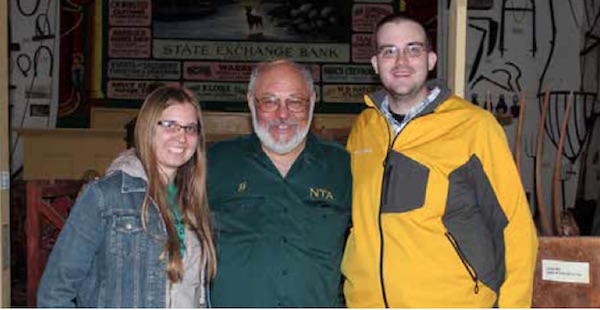
(L-R) Sarah Karas, Cobblestone Museum co-coordinator, John Janelli, and Matt Ballard, co-coordinator
Members of the Committee visited the Museum to see the fox firsthand on May 23, 2014 (shown above) when it was decided that the restoration of this artifact was not simply a possibility but a necessity. Heat from being stored in an attic for decades, along with freezing in the winter, had led to severe deterioration. One eye had fallen out, the tail had “melted,” the paws were void of hair and bugs had found their way inside. Melissa Ierlan, Town of Clarendon Historian, said, “It was in bad shape. We thought we would have to replace it, but we didn’t.”
The fox is depicted eating a bird it had caught. The paper mache work on the bird included newspaper from the Holley Standard, dated December 4, 1879. As an important symbol of modern taxidermy’s founding father, the fox needed to be restored and preserved.
On June 5, 2014, the Museum coordinators, Ballard and Karas, presented the proposal to the board of trustees. With a unanimous yes, the board offered their support in the effort to preserve Akeley’s little red fox. Fundraising begin immediately to procure funding for the evaluation and proper restoration of this important piece of history.
The fundraising to enable the restoration was a major project in itself. Ierlan said the restoration resulted from an “amazing grass-roots effort to secure funding” for the project. Private donors, a grant from the Elizabeth Dye Curtis Foundation and donations from the Orleans County Chapter of the Daughters of the American Revolution, Orleans County Historical Association (OCHA) and the Clarendon Historical Society made the project possible.
With funding in place, Melissa Ierlan personally bubble wrapped and transported the fox in her car to the restoration offices of George Dante in New Jersey.
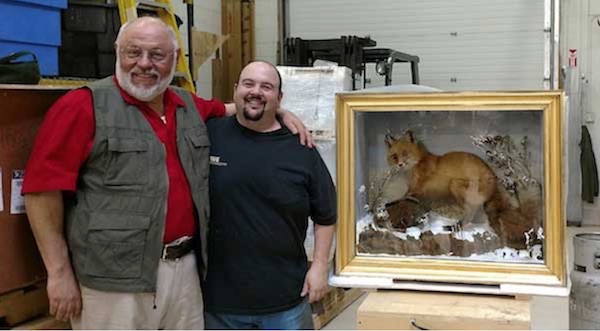
Photo courtesy of Melissa Ierlan: John Janelli, left, is past president of the National Taxidermy Association. He is pictured with George Dante of Wildlife Preservations, LLC, and the refurbished fox at Dante’s studio. Dante has provided taxidermy exhibition services to the American Museum of Natural History in New York City, and Harvard University’s Museum of Comparative Zoology.
Bill Lattin, retired Orleans County Historian and former Cobblestone Museum Director, has a family connection to the fox. He explained that his great-grandfather, Francis Harling of Albion, procured the fox for Akeley. Lattin explained that the fox, enclosed in a framed diorama, is a precious artifact. “In the world of taxidermy, it’s like owning a Rafael,” Lattin said. “It’s very, very special.”
Akeley (1864-1926), is known as the Father of Modern Taxidermy. He devised a method for fitting an animal’s skin over a meticulously prepared and sculpted form of the animal’s body. The process included the animal’s musculature and details such as wrinkles and veins and produced a very realistic result.
Lattin said his great-grandfather wanted the fox diorama to display in the family’s home on East County House Road in Albion. Harling was a middle-class dirt farmer and blacksmith, Lattin explained, but noted it is interesting that, “common ordinary people (of that time) had a sensitivity for aesthetics.” Harling had gone out of his way to procure the fox, Lattin said, so that something beautiful could be made to decorate the family’s home, “that’s remarkable,” he observed.
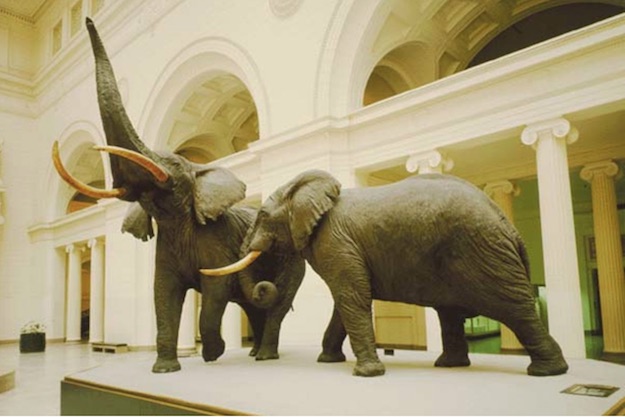
Akeley’s African Elephant Exhibit, courtesy of the Field Museum, Chicago
Akeley made many trips to Africa to collect specimens and created the African Hall at the American Museum of Natural History in New York City. Akeley also liked to place the mounted animals in settings that reflected their native habitat. Lattin also explained that during the Akeley Fox restoration, it was discovered that what was thought to be a “tod” (male fox) was found to be a “vixen” (female fox).
In 2017, Melissa Ierlan made a return trek to New Jersey to pick up the fully restored vixen fox. A “welcome home” celebration was held in September 2017 at the Museum’s Cobblestone Church. At the celebration, shown above, Matthew Ballard (Orleans County Historian), Bill Lattin and Melissa Ierlan pose with Carl Akeley’s restored fox diorama.
Jay Kirk, the author of the book, “Kingdom Under Glass” (shown above), a book about Carl Akeley and his work, attended the celebration as did Akeley expert, John Janelli. County Historian Matt Ballard said, “We wanted to bring (the fox) to the attention of people who would appreciate Akeley’s work.” The fox is part of a transitional phase for Akeley. Ballard noted the legwork done by Ierlan, the Clarendon historian, to have the fox restored as well as the importance of the local fundraising effort. “It’s surreal to see it come to fruition,” Ballard said of the restoration project. “It’s a piece of national significance.”
At the celebration, Ierlan discussed Carl Akeley’s life and work from his humble beginnings on Hinds Road in Clarendon to the jungles of Africa. “He was the original Indiana Jones,” Ierlan said. She noted his early work preserving the pet canary of his aunt, his training in taxidermy by David Bruce in Brockport and his apprenticeship at Ward’s Natural Science Establishment in Rochester. She explained that the taxidermy work done before Carl Akeley arrived on the scene, often made animals look like stuffed toys. Akeley wanted “to make them look as real as possible,” Ierlan said.
Melissa Ierlan brought copies of photographs of Akeley’s work including diorama’s from the American Museum of Natural History and the entourage that accompanied Akeley on his African trips to collect specimens (far left), as well as the condition of the fox diorama prior to restoration.
The Cobblestone Museum has prepared a short video to provide additional information for those who missed out attending the Akeley celebration. It can be viewed by clicking here along with a collection of other videos on local history.
In addition to his taxidermy work, Akeley was an accomplished sculptor, biologist, conservationist and inventor with over 29 patents. Akeley improved the motion picture camera for filming animal movement. Ierlan said, “He had a remarkable life. He was one of America’s greatest men.”


















